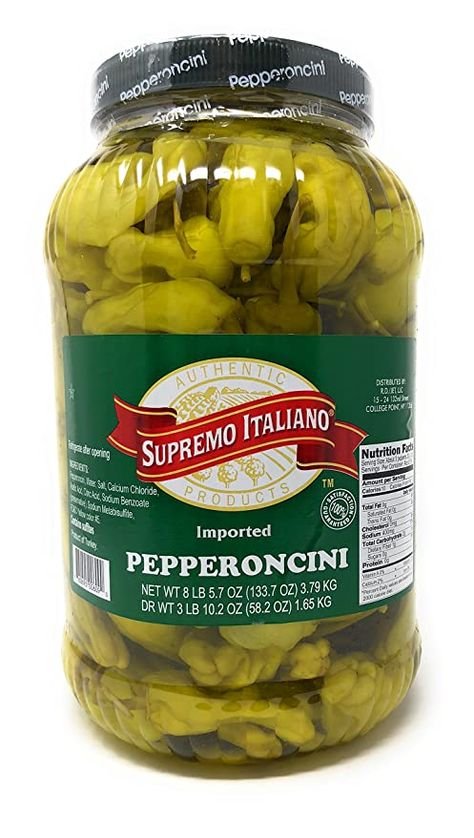Pepperoncini is a popular type of mild chili pepper that adds a tangy and slightly sweet flavor to various dishes. Often pickled and used as a topping or ingredient in salads, sandwiches, and pizzas, pepperoncini has gained widespread popularity. Originating from Italy and Greece, this pepper is now enjoyed worldwide.
Table of Contents
Pepperoncini: Origins and History
The history of pepperoncini dates back to ancient times when Mediterranean cultures first cultivated this flavorful pepper. It is widely used in Italian and Greek cuisines, known for its mild heat and slightly sour taste. The name pepperoncini comes from the Italian word “peperoncino,” which means small pepper.
Pepperoncini: Nutritional Benefits
Including pepperoncini in your diet can offer various health benefits. This pepper is rich in vitamins and minerals, making it a healthy addition to meals. Some of the key nutritional benefits of pepperoncini include:
- Rich in Vitamin C: Boosts the immune system and promotes skin health.
- Low in Calories: A great option for those looking to maintain a healthy diet.
- Good Source of Fiber: Supports digestion and gut health.
- Contains Antioxidants: Helps fight inflammation and oxidative stress.
Pepperoncini: How It’s Grown and Harvested

The cultivation of pepperoncini is relatively easy, making it a favorite among home gardeners. It thrives in warm climates and well-drained soil. The growing process includes:
- Planting Seeds: Typically started indoors before being transferred outside.
- Sunlight and Watering: Requires full sun exposure and regular watering.
- Harvesting: The peppers are picked when they turn a vibrant yellow-green color.
- Processing: Often pickled for preservation and enhanced flavor.
Pepperoncini: Different Types and Varieties
While most people recognize the common pickled pepperoncini, there are different varieties available:
- Italian Pepperoncini: Slightly sweeter with a mild heat level.
- Greek Pepperoncini: More tangy and slightly spicier than the Italian variety.
- Fresh Pepperoncini: Used in cooking for a natural, crisp texture.
- Pickled Pepperoncini: The most common type, often found in jars and used as a condiment.
Pepperoncini: Culinary Uses and Recipes
Pepperoncini can be used in numerous dishes to add a burst of flavor. Some popular ways to use pepperoncini include:
- Salads: Adds a tangy crunch to Greek and Italian salads.
- Sandwiches and Burgers: Enhances the taste with a mild spice.
- Pizza Topping: Commonly used in pizzerias for extra zest.
- Pasta Dishes: Blends well with tomato-based sauces.
- Marinated Meats: Works great in marinades and slow-cooked dishes.
A simple pepperoncini recipe to try: Pepperoncini Pasta Salad Ingredients:
- 1 cup sliced pepperoncini
- 2 cups cooked pasta
- 1/2 cup cherry tomatoes
- 1/4 cup feta cheese
- 2 tbsp olive oil
- Salt and pepper to taste
Instructions:
- Cook pasta according to the package instructions.
- In a bowl, mix pasta, pepperoncini, cherry tomatoes, and feta cheese.
- Drizzle with olive oil and season with salt and pepper.
- Serve chilled or at room temperature.
Pepperoncini: Health Benefits Beyond Nutrition

In addition to being nutritious, pepperoncini also provides other health benefits:
- Boosts Metabolism: The mild spiciness can help enhance metabolism.
- Supports Heart Health: Helps in reducing cholesterol levels.
- Aids Digestion: Promotes gut health and prevents bloating.
- Anti-Inflammatory Properties: Helps in reducing inflammation in the body.
Pepperoncini: How to Store and Preserve
To keep pepperoncini fresh, proper storage is essential:
- Refrigeration: Fresh pepperoncini should be stored in the fridge.
- Pickling: The most common preservation method for pepperoncini.
- Drying: Dried pepperoncini can be used as a spice in cooking.
- Freezing: Helps maintain the texture and taste for longer periods.
Pepperoncini: Frequently Asked Questions
Is pepperoncini spicy? No, pepperoncini is considered a mild pepper, with a Scoville Heat Unit (SHU) rating of around 100-500.
Can you eat raw pepperoncini? Yes, pepperoncini can be eaten raw, though it is often pickled for enhanced flavor.
What is the difference between pepperoncini and banana peppers? While similar, pepperoncini has a slightly more wrinkled skin and a tangier taste compared to banana peppers.
Are pepperoncini good for weight loss? Yes, pepperoncini is low in calories and high in fiber, making it a great choice for weight management.
How long does pickled pepperoncini last? When stored properly, pickled pepperoncini can last up to a year in the refrigerator.
Also read What Beats Rock The Ultimate Guide to Winning Strategies
Pepperoncini: Conclusion
Pepperoncini is a delicious and versatile pepper that adds unique flavor and health benefits to various dishes. Whether eaten fresh, pickled, or cooked, pepperoncini is a fantastic addition to any diet. With its mild heat and tangy taste, it continues to be a favorite ingredient worldwide. From salads to sandwiches and even pasta, pepperoncini is a must-have in any kitchen.


